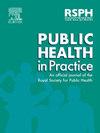The health for hearts united dissemination Trial: Implementation costs to reduce cardiovascular risk in African Americans
IF 1.9
Q2 PUBLIC, ENVIRONMENTAL & OCCUPATIONAL HEALTH
引用次数: 0
Abstract
Objectives
We report on the implementation costs of disseminating Health for Hearts United (HH), a church-based intervention designed to reduce CVD in African Americans.
Study design
Cost analysis from dissemination trial of the CVD risk reducing, HH Intervention.
Methods
Total costs included materials purchased and labor hours contributed by the academic team to implement the intervention. Materials costs included supplies and printing calculated in total, as well as on a per-participant basis. Labor hours were tracked for each team member. Labor hours were further categorized by the phase of the intervention (Training, Planning & Coaching, Delivery & Recognition). Per-participant and per-church costs are reported as the cost measurement divided by the total health leaders that participated (reached).
Results
A total of n = 168 out of 173 health leader participants were reached (97 %). Total program costs were $87,207.66. Total material costs were $13,308.00, while labor costs accounted for 85 % of the total program costs ($87,207.66) at $73,899.66. The Training Phase comprised the largest portion (74 %) of the total labor costs ($54,598.29). Total per-health leader participant reached cost were $519.09.
Conclusions
In one of the first studies to report the costs of implementing a CVD risk reducing intervention among African Americans in a church setting, in partnership with a local academic institution, training was the main cost driver. Costs of implementing HH could be reduced by lowering hourly labor cost. Future research should examine costs associated with different methods of implementation (e.g., using more lay people).
心脏健康联合传播试验:降低非裔美国人心血管风险的实施成本
目的:我们报告了传播“同心健康”(HH)的实施成本,这是一项以教会为基础的干预措施,旨在减少非裔美国人的心血管疾病。研究设计:降低心血管疾病风险、HH干预的传播试验成本分析。方法总成本包括采购材料和学术团队实施干预的人工时间。材料费包括耗材和印刷费,按总数计算,也按每个参加者计算。跟踪每个团队成员的劳动时间。工时进一步按干预阶段分类(培训,计划和;培训、交付&;识别)。每个参与者和每个教会的成本报告为成本测量除以参与(达到)的总卫生领导。结果173名健康领导被访者中,被访者168人(97%)。项目总成本为87,207.66美元。总材料成本为13,308.00美元,而人工成本占总项目成本的85%(87,207.66美元),为73,899.66美元。培训阶段占总人工成本的最大部分(74%)(54,598.29美元)。每个健康领导者参与者达到的总成本为519.09美元。在与当地学术机构合作的一项研究中,首次报告了在教堂环境中对非裔美国人实施心血管疾病风险降低干预的成本,培训是主要的成本驱动因素。实施HH的成本可以通过降低小时劳动力成本来降低。未来的研究应检查与不同实施方法相关的成本(例如,使用更多的非专业人员)。
本文章由计算机程序翻译,如有差异,请以英文原文为准。
求助全文
约1分钟内获得全文
求助全文

 求助内容:
求助内容: 应助结果提醒方式:
应助结果提醒方式:


